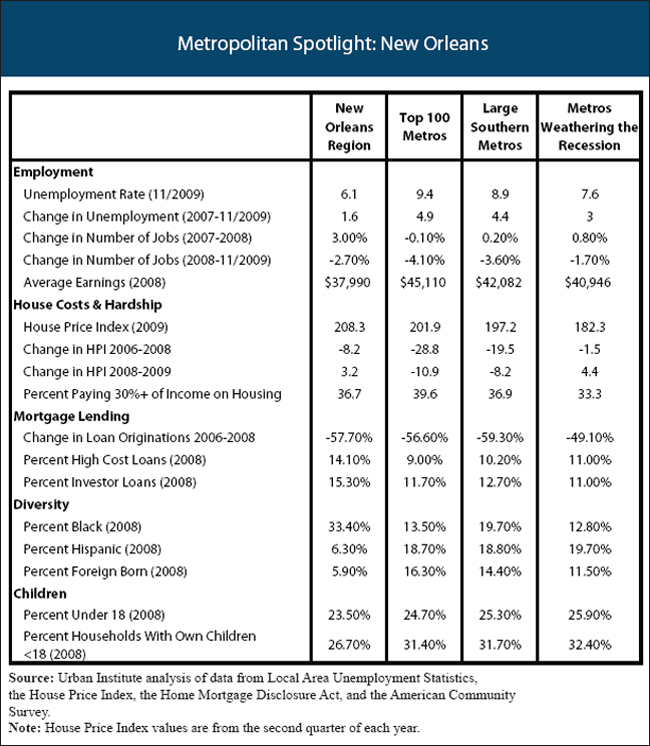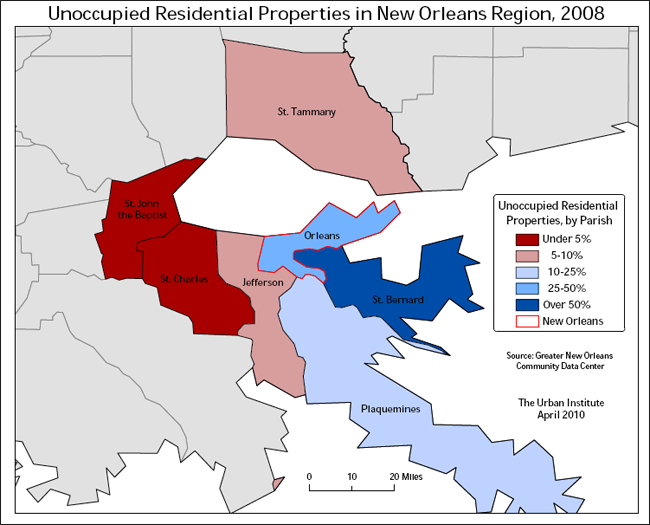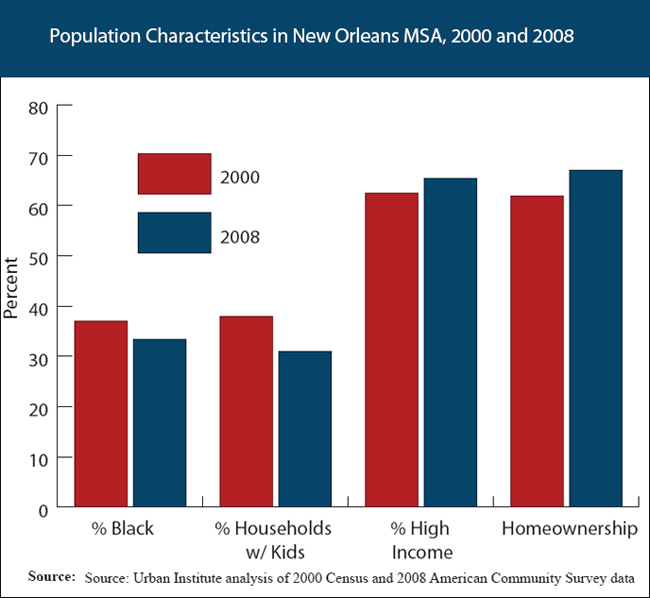
|
|
Metropolitan Spotlights New Orleans Metropolitan RegionIn August of 2005—at the peak of the nation's economic boom—New Orleans was hit by Hurricane Katrina. Jobs, homes, and people were all washed away in the subsequent flooding. Since then, the region has been struggling to rebuild its housing stock, reinvigorate its economy, and recover its residents. Federal funding has fueled much of the rebuilding effort, and the region's population today totals 91 percent of its pre-Katrina level. The region's central city—Orleans Parish—bore the brunt of the storm's damage when the levees protecting it failed, and has regained only 79 percent of its pre-Katrina population. Because it was in the midst of a publicly funded rebuilding effort when the recession hit, the New Orleans region initially fared pretty well, especially compared to other big metros in the South. Although unemployment has climbed—from 3.5 percent in 2007 to 6.1 percent at the end of 2009—the increase was small by national standards. And only 5 of the top 100 metros had lower unemployment rates as of November 2009. Between 2007 and 2008, when most regions were losing jobs, New Orleans was still gaining jobs. But the magic of the rebuilding investments may be waning. In 2008, New Orleans began to lose jobs, though still at a slower rate than many other metros. The region's housing recovery has also sagged considerably, although again, many other metros have been hit much harder. The regional House Price Index dropped 8.2 points between 2006 and 2008—compared to an average 28.8 point drop among the top 100 metros nationwide. And the most recent figures show a small gain between 2008 and 2009. At latest estimate, New Orleans' housing price index—at 208.3—stands above the average for the top 100 metros. The number of mortgage loan originations in greater New Orleans dropped 58 percent between 2006 and 2008, slightly more than the average for the top 100 metros nationwide. But this may reflect the fact that 2006—the first full year post-Katrina—saw an unusual volume of market activity. Subprime products account for a larger share of mortgage originations than in most metros nationwide. And a relatively large share of mortgage loans are going to investors (rather than owner-occupants)—15 percent in 2008, higher than all but 17 other big metros. Despite the infusion of funding and jobs since Katrina, annual earnings averaged only $38,000 region-wide in 2008, well below the average for the nation's 100 biggest metros and near the bottom among big metros in the South. Only 20 of the top 100 metros nationwide have lower average earnings. And because housing costs have risen faster than wages since Katrina, housing hardship is widespread across the New Orleans metro region. As of 2008, 37 percent of the region's households paid more than 30 percent of their income for housing, a share that's defined as "unaffordable" by federal standards. That puts New Orleans in the middle of the pack nationally—46th highest out of the 100 largest metros—in terms of housing hardship. Orleans Parish and its neighbor Saint Bernard Parish were hit hardest by Hurricane Katrina, and are both still struggling economically compared to the rest of the region. For example, sales tax revenues in March 2009 were only back to 86 percent of pre-Katrina levels in Orleans Parish and 71 percent in Saint Bernard, compared to over 200 percent in St. Charles and St. Tammany. Similarly, in March 2010, the number of occupied residential addresses in Orleans Parish was only back to 79 percent of its pre-Katrina total, and St. Bernard was still at 54 percent, while St. Charles, St. John, and St. Tammany had all exceeded their pre-Katrina totals. These disparities are mirrored by data on the number of employers and levels of personal income, all reported in the New Orleans Index, produced by the Greater New Orleans Community Data Center and the Brookings Institution. Before Katrina, the New Orleans region had a large African American population but few immigrants. After the storm, the number of foreign born residents rose precipitously, with Hispanic workers attracted by the recovery and rebuilding jobs. The latest data suggest that the share of immigrants in the region's population is dropping again, down to 5.9 percent in 2008 from 7.1 percent in 2007. New Orleans' immigrant population remains one of the smallest nationwide. Children constituted a relatively large share of the region's population at the start of the century, but that too has changed as a result of Hurricane Katrina. In 2008, 24 percent of residents in Greater New Orleans were under 18, down from 26 percent in 2004. Many families with kids had to evacuate after Katrina, and these households have returned more slowly than singles or childless couples. Today, African Americans and families with kids account for smaller shares of the region's population than a decade ago, while higher income households and homeowners account for larger shares. These changes reflect the challenges (and opportunities) of living in a region that's recovering from a devastating natural disaster. Although publicly funded rebuilding investments may have staved off some of the worst effects of the recession, New Orleans' future prosperity remains in question. The region was losing both jobs and population long before Hurricane Katrina struck. At latest count, total employment still fell short of pre-Katrina levels and even before the latest environmental catastrophe hit—with its likely economic ripple effects—the most optimistic regional economic(ppt) forecasts(xls) anticipated slow growth in the coming years. Related resource: |
Share
Feedback Metropolitan Spotlights Related Resources |







